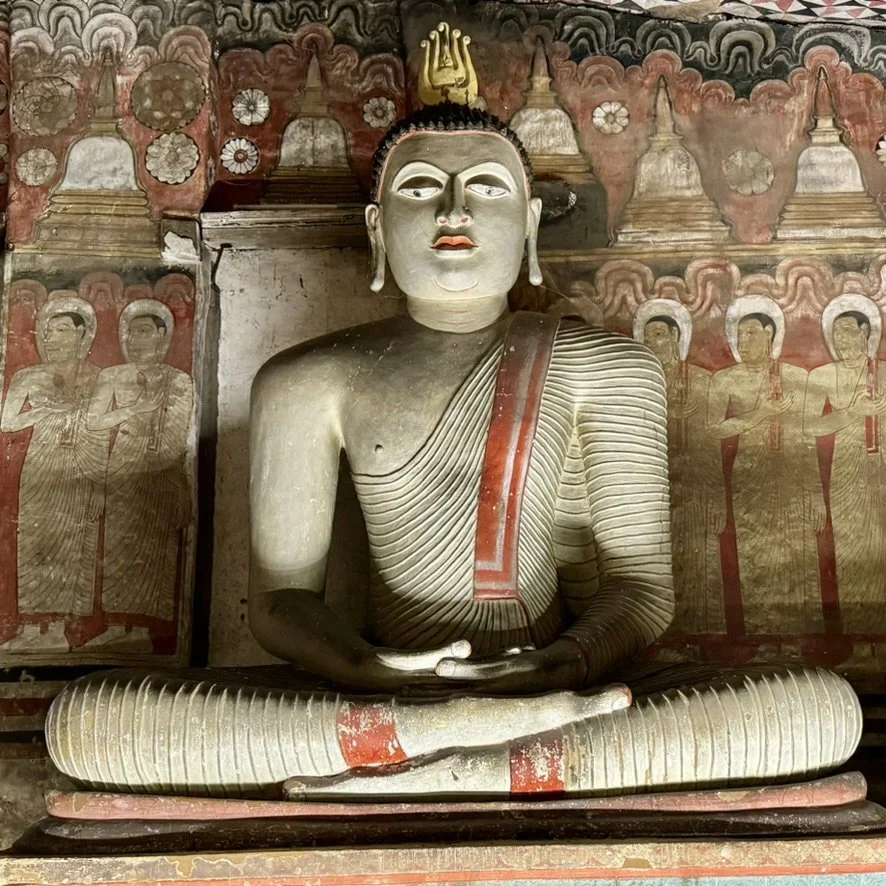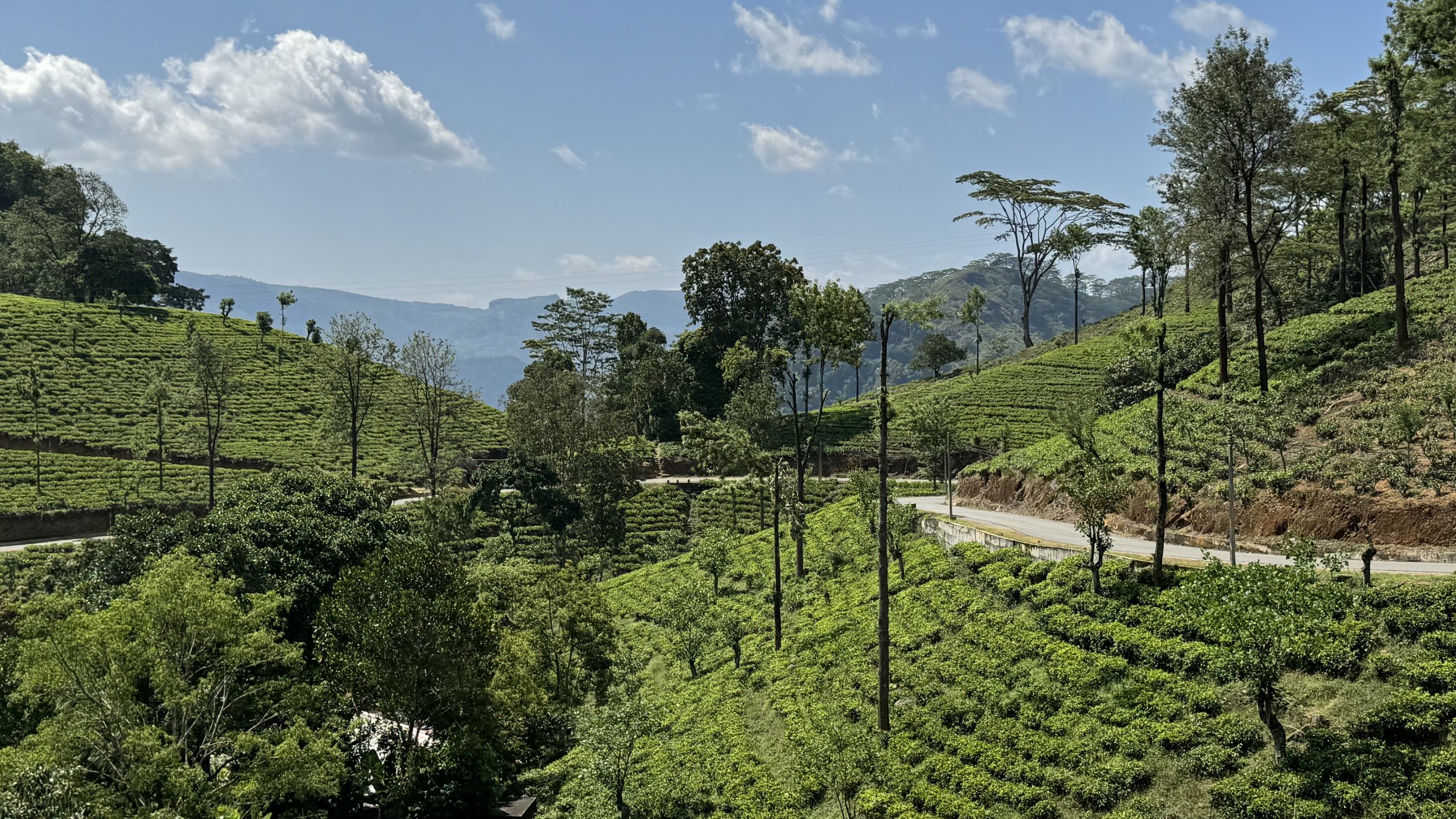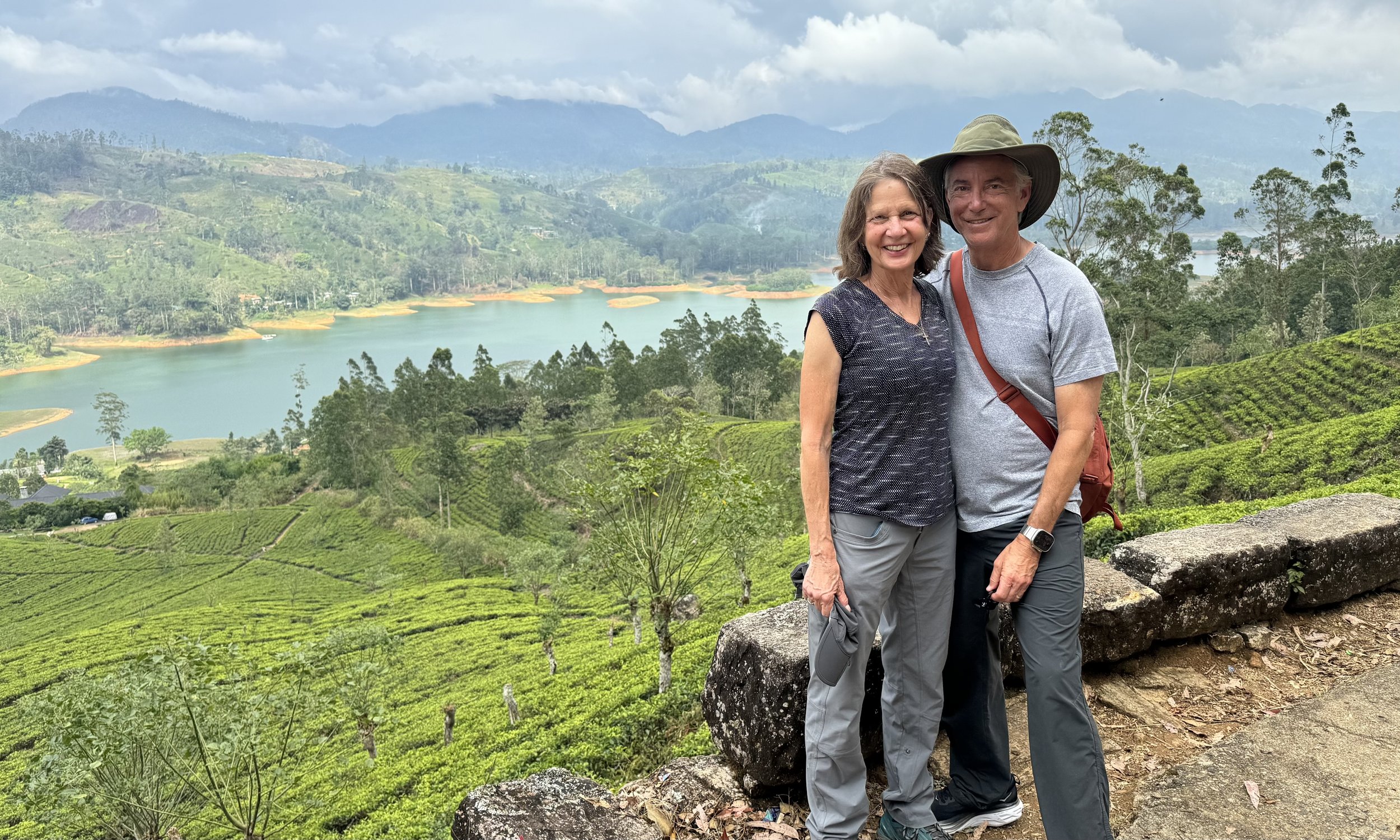Sri Lanka & Maldives 2024
The island name of Sri Lanka translates into “The Resplendent Island”, which means dazzling, magnificent or glorious. After spending 2 weeks on the island, we agree that Sri Lanka is magnificent! Sri Lanka lies 45 miles southeast of India and has a very interesting history and culture, and an amazing wild, natural beauty. We drove through most of Sri Lanka which included: the capital, Colombo, the Ancient Cultural Triangle, the Tea Country, the National Parks/Safaris and the colonial city of Galle.
We arrived in Colombo after our long 25-hour plane journey. We spent the day walking the city to view the historical sites and old colonial buildings while enjoying some of the local street food. Colombo and the west coast of Sri Lanka were first populated by the Portuguese who were seeking cinnamon and spices in the mid-1500’s. They were followed by the Dutch who fortified the ports and were then overtaken by the British in 1815. The British built roads and railroads and brought and developed the famous Ceylon Tea industry. Sri Lanka then became independent in 1948.
After our brief visit to Colombo, we drove to the central area of Sri Lanka, known as the Ancient Cultural Triangle, and includes: the Sacred City of Anuradhapura, the Ancient City of Polonnaruwa, the Ancient City of Sigiriya, the Ancient City of Dambulla and the Sacred City of Kandy.
Our first stop in the Cultural Triangle was Anuradhapura, where we road bikes throughout the key areas. Anuradhapura was first established in the 3rd century B.C. when a cutting from the “tree of enlightenment”, Buddha’s fig tree, was brought to Sri Lanka and this event was the founding of Buddhism in Sri Lanka. Anuradhapura thrived for 1300 years, not only as a research institution, but also as the religious and political capital. Buddhist monks from across the country and from other countries learned, new skills and then, either continued their studies in Anuradhapura or returned to their communities teaching the new knowledge and skills they gained. The city remains were first discovered in the 19th century by the British.
We then visited and explored the Dambulla Cave Temples which have been sacred pilgrimage sites for 22 centuries. This cave monastery, with its five sanctuaries, is the largest, best-preserved cave-temple complex in Sri Lanka. The Buddhist mural paintings are of particular importance, as are the 157 statues.
We also visited and hiked Sigiriya, an ancient rock fortress known as “Lion Rock”. This large rock is an ancient lava plug which juts out 200 meters in a mostly flat area of the north central part of the island. Near the base of the rock are enormous lion paws and evidence of where a giant lion head of stone was once located. A Sri Lankan legend tells us how an Indian prince, who was the grandson of a lion, traveled to Sri Lanka and married a princess and from this union, the Sinhalese race was born (sinhala means “of lions”). In Sinhalese tradition, the lion is the mythical ancestor of kings. Also, there is evidence of humans here which date back 5500 years, with indications that the area was populated as a Monastery and then, a King’s Palace which had an extensive network of gardens, fountains, reservoirs and other structures.
Polonnaruwa, which was our next stop, was the second capital of Sri Lanka after the destruction of Anuradhapura in 993. Polonnaruwa was comprised of Royal Palaces, temples, monuments, government buildings and residences which are still in remarkably good condition. It was here, in 1150 AD, that King Parakramabahu the Great constructed elaborate irrigation systems and built damns which was essential for their agricultural development.
Our final Cultural Triangle visit was to Kandy, which coincided with a full moon Holy Day. Kandy was the last stronghold of the ancient Buddhist political period and is now considered the Cultural Capital of Sri Lanka. Kandy is also the home of the Temple of the Tooth, which houses Sri Lankan’s most important religious relic… Buddha’s tooth. It was believed that whoever holds the relic, holds the governance of the country. During the Full Moon Holy Day, pilgrims from all over the country travel to Kandy to view the holy relic which is put out on display in the temple.
On our second day in Kandy, we hiked in the Knuckles mountain range which is known for the knuckle-shaped mountains, it’s lush rainforest and unusual wildlife and leeches! (Yes – we experienced leeches up close and personal). Finishing our Kandy visit, we toured with a very knowledgeable and engaging botanist at the Peradeniya Royal Botanical Gardens.
We left Kandy and took a scenic train ride into the Tea country. The tea plantation area was incredibly scenic with rolling green hills, and covered with waist-high tea trees which are maintained weekly with care and harvesting. Barefoot women climb the hills with large bags hanging from their heads, and with their hands, they pluck off the top new leaves and buds, which are then sent to nearby factories to be dried and processed. We observed tea harvesting and village life when we hiked 16km of the Peoke Trail through the central highlands.
We spent two full days at Yala National Park near the southern tip of the island. Our accommodations were in “glamping tents” located near the park which enabled us to view the wildlife, birds, and reptiles, but none were more exciting that seeing the leopards. Since there are no lions or tigers in Sri Lanka, this beautiful cat of the panther family is the “King” of the forest in Sri Lanka. We also saw, elephants, water buffalo, crocodiles, wild boar, spotted deer, peacocks, monkeys and a variety of different birds since Sri Lanka has over 400 different birds throughout the island.
Our final stop was Galle, where the Portuguese landed in the 16th century and then, were followed by the Dutch and British. Galle has a wonderful colonial character and architecture. During our visit, we shopped and cooked a meal with a local family and did a bike and a river boat tour through the rural areas of Galle.
Maldives "Garland of islands"
We have always dreamed of going to The Maldives. We had visions of hundreds of islands and coral reefs around atolls, white sandy beaches, vibrant shades of clear blue water and staying in bungalows over the water. Visiting here was a dream come true!
The Maldives are located 470 miles southwest of India and Sri Lanka and are an archipelago of 1192 islands across 26 atolls. We learned that atolls are formed from prehistoric volcanoes in the Indian Ocean that have gone extinct, and as the ocean floor subsided from the volcano, coral begins to populate and grow around the volcano ring and forms a fringed reef. As time passes, the reef slowly becomes a barrier reef enclosing a shallow lagoon inside. The islands have an average ground-level elevation of 1.5 meters above sea level making it the world's lowest-lying country. Also, 70% of the beautiful white sand we walked on is generated by Parrotfish biting and feeding on coral and then excreting the hard coral that becomes sand.
Our days in the Maldives were on the atoll called “Laamu” where we explored the island snorkeling, biking, paddleboarding, and relaxing. We also visited a small village on a local island and learned about the coral reefs, sea life and how the NGO’s are working to save and/or restore the natural life in the area.
Colombo
Street Food
Khan Clock Tower
Best tea shop in Colombo
Common village setting along roads on our way to the Cultural Triangle
Farmers overnight tree house to keep elephants from eating rice
Harvesting coconuts. All parts of the coconut tree are used in Sri Lanka
Farmer with herd of Water Buffalo
Water Garden Hotel with view of Sigiriya Rock
Bike ride around Kingdom of Anuradhapura (Ancient Capital 4th Century BC - 11th Century AD)
Jetavanarama Dagoba - Dome shaped Shrine with relics
Anuradhapura - Moon stone at entrance to building
Guard stones at entrance of ruins
View from hike to Dambulla Cave Temple
Dambulla Caves dating back to 1st Century BC - 5 separate caves containing 150 Buddha statues
Dambulla Caves - 45 ft long reclining Buddha
Brilliantly colored frescos throughout the caves
Elephant passing lane!
Sigiriya Rock (aka Lion Rock) - Started as a Fortress, became a Monastery and finally a Palace
Money playing at the former water gardens of Sigiriya Palace
Sigiriya Rock Lion paws. The entrance to the rock palace was between the paws and into the mouth of the lion (the head no longer exists)
Sigiriya Rock water garden view from the top of the rock
Top of the rock has foundations of palace. The reservoir on top was carved out of solid rock
Magnificent view of the countryside from the top of Sigiriya Rock
View of the Lion paws from above
Visiting the Kingdom of Polonnaruwa. Ancient capital from 8th Century AD till 1300 AD
Royal Palace of Polonnaruwa
Semi-circular moonstone at the entrance of buildings
Elaborate stair railings
Audience hall
Tooth Temple Buddha Statue
Vatadage entrance - Circular relic house
Vatadage Buddha Statue
Lankathilaka - Cathedral like building that leads to a huge Buddha statue
Gal Vihara Buddha Statue, one of the 4 separate rock carvings made from one slab of granite
City of Kandy. 1592 Kandy became the Capital. Remained independent till 1815 under British rule
Temple of the Tooth houses the holy relic of Buddha’s tooth.
Pilgrims come to view the relic on a full moon Holy Day
Sacred tooth display
Ancient ceiling frescos
Flowers for pilgrims to purchase for gift to the temple
Drive up the mountain for Knuckles mountain hike
Tea leaf pickers starting the work day - $5 per day
View from our hike
Leaf nosed lizard
Knuckles Mountain ridge
Sri Lanka’s gray orchid at the Kandy Botanical Garden
Kandy Botanical Garden
Country side view from train ride
View of small town from train ride
Dunkeld Estate Tea Plantation
Dunkeld tea factory tour
Dunkeld tea fields and leaf pickers
Lunch overlooking the tea fields and Castlereagh reservoir
Overlooking Castlereagh reservoir on our way to start our village hike
Hindu stature along village hike
Hindu Temple
Tea plantations village
Children on their way to school
Adam’s Peak. Tallest mountain in Sri Lanka. Sacred site to 3 religions; Islamic, Buddhist and Christian
BBQ lunch at the hotel
Castlereagh reservoir
Views along drive to Yale National Park
Kingfisher
Peacock drying wings in morning
Water Buffalo and friends walking by our Glamping site
Leopard enjoying a small catch
Painted Stork
Sri Lanka’s national bird = Ceylon Jungle Fowl
Galle City beach
Entrance to Galle Fort
Galle Fort Dutch Reformed Church
Galle
Galle lighthouse dating back to the 19th Century
Galle City center
Shopping at the market for our cooking class
Our cooking ingredients
Delicious meal! Spicy shrimp, curries, vegetables and rice
Indian Flying Fox … or Fruit Bats. Known as one of the largest bats in the world.
Purple Heron
Chef in the field preparing our meal after a bike ride
Yummy Egg Hoppers with local spice and coconut milk
Farmer rounding up chickens. We enjoyed fresh eggs for our hoppers!
View of Male from above. Capital of Maldives
One of the 26 atolls in the Maldives
Breakfast at our resort
Turtle!
Only bikes are permitted on the atoll.
Toured a small village on the same atoll but a different island
The village’s ancient church
Dinner at our resort
Flight from our atoll to Male to catch our flight home

























































































































